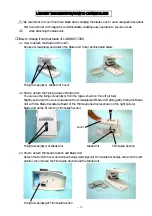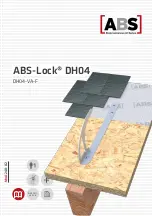
This is a publication by Conrad Electronic SE, Klaus-Conrad-Str. 1, D-92240 Hirschau (www.conrad.com).
All rights including translation reserved. Reproduction by any method, e.g. photocopy, microfilming, or the capture in electronic data
processing systems require the prior written approval by the editor. Reprinting, also in part, is prohibited. This publication represent
the technical status at the time of printing.
© Copyright 2015 by Conrad Electronic SE.
Short circuit/connection
In case of a short circuit only the indicator “B“ on the MASTER unit is shown. The display of the
BNC remote unit remains blank.
After the operation indicator flashes 9 times, the display “B“ on the MASTER unit is shown. The
LED on the BNC remote unit remains blank.
Switching off
To turn off, slide the operating switch to the “OFF” position.
Maintenance and cleaning
Apart from occasional cleaning and battery replacements, the measuring device requires no
servicing.
The outside of the device should only be cleaned with a soft, damp cloth or a brush. Never use
aggressive cleaning agents or chemical solutions since these might damage the housing or
impair the operation.
Disposal
a) General aspects
Electronic products are recyclable material and do not belong in the household
waste. Dispose of the unserviceable product in accordance with the relevant statu-
tory regulations.
Remove any inserted battery and dispose of it separately from the product.
b) Batteries and rechargeable batteries
As the end user, you are required by law (Battery Regulation) to return used batteries. Do not
dispose of used batteries in the household waste!
Batteries/rechargeable batteries containing harmful substances are marked with the
following symbols, they point out that they are not allowed to be disposed of in the
household waste. The symbols of the critical heavy metals are: Cd = cadmium,
Hg = mercury, Pb = lead (the marking can be seen on the batteries, e.g. underneath
the refuse bin symbol shown on the left).
You can return your used batteries/rechargeable batteries free of charge at the official collection
points of your community, in our stores, or at places where batteries or rechargeable batteries
are sold!
You thereby fulfil your statutory obligations and contribute to the protection of the environment!
Technical data
Power supply ........................................9 V block battery (6F22, 1604 or structurally identical)
Current consumption ............................approx. 12 mA
Measuring principle ..............................electrical resistance
Cable type RJ-45 ..................................CAT-5, CAT-6, CAT-7
..............................................................
STP/FTP shielded, UTP unshielded
Cable type RJ-11/RJ-12 .......................6P6C, 6P4C, 6P2C
Cable type BNC ....................................Coaxial
Cable length max. .................................≥300 m
Operating conditions .............................0 °C to +50 °C / 10% to 90%rF (not condensing)
Storage conditions ................................-10 to +60 °C / 10% to 90%rF (not condensing)
Weight ..................................................approx. 165 g
Dimensions (L x W x A) ........................120 x 102 x 30 mm
RJ-45:
When checking the RJ-45 cable, plug the two plugs of the cable to be tested into the jacks with
the label “RJ-45” (5 and 8).
The display corresponds to the entire area of LEDs 1 to 8, respectively “G” (shielding) and
“B”. (BNC).
The possible indications are:
Continuity/cable allocation
If the cable is OK, the core indicator is shown both on the MASTER and REMOTE unit. The
cable allocation can also be identified by this display. The indication “G” appears by shielded
cables only.
Interruption
In case of an interruption, no indication on the MASTER unit and no indication on the REMOTE
unit are shown.
The display example, shows the interruption at core 2 and 4. The relevant displays remain off.
Short circuit/connection
In case of a short circuit only the indicator on the MASTER unit is on. The display of the relevant
core remains off on the REMOTE unit.
The display example shows the short circuit iat core 1 and 2. The relevant displays light up on
the MASTER unit, but remain off on the REMOTE unit.
Testing the Coaxial BNC Cable
For this test the MASTER unit and the small BNC remote unit (13) are used.
To test the coaxial BNC cable, connect one BNC plug of the cable to be tested to the
BNC jack (3) of the MASTER unit. On the other cable end, connect the BNC remote unit (13).
The display corresponds to LED „B“ on the MASTER unit and to the LED at the top of the
BNC remote unit.
The possible indications are:
Continuity
If the cable is OK, the core display „B“ on the MASTER unit and on the BNC remote unit light up
briefly. After the operation indicator flashes 9 times, the display „B“ is shown.
Interruption
In case of an interruption, no indication on the MASTER unit and no indication on the
BNC remote unit will be shown.
The operation indicator flashes 10 times for each continuity; however, indicator „B“ is not on.
The LED of the BNC remote unit remains blank.


























